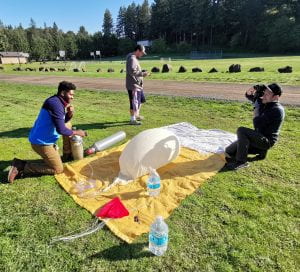Exploring the Troposphere/Stratosphere – High Altitude Ballooning
Helium Filling Team
We are always trying to improve the skills of our university community members. This week under the inspiration of Mark Fonstad from the Geography Department we trained a few colleagues on how to fill a helium weather balloon to collect research data on the troposphere and stratosphere. We used a 600 gram balloon and filled with approximately 90 cubic feet of helium at ground level. The payload consisted of set of cameras, a data logger (temperature, barometric pressure, and humidity) and a beacon system for tracking the balloon. We used the High Altitude Science calculator to determine the needed volume of helium to lift the payload and move it upward at a set rate of ascent. We also used the Cambridge University Spaceflight Landing Predictor to provide data on where to recover and launch the balloon payload system. In this case Mark and I selected the recovery site first. This allowed us to pick a place on public lands away from dense forest canopy. The selected endpoint was an area just north of the Pine Mountain Observatory in central Oregon. Based on the endpoint several starting locations and rates of ascent were tested until we found a spot and rate that resulted in a landing near the desired location. We also selected a specific parachute size based on data from Rocket Simulator for the payload to further aid in achieving a landing in the desired recovery zone. The payload broadcasted its position using a Big Red Bee 70 cm radio beacon and a 70 cm APRS GPS beacon. I built a 70 cm Yagi antenna for a Yaseu VR7x radio to aid in tracking the radio beacon. We tracked the other APRS radio beacon using a Kenwood D74 radio. We also used an additional Baofeng UV-5R radio in one of the chase cars. Unfortunately, weather is fickle and the winds dropped more than expected allowing the balloon to rise at a faster rate without traveling as far east as expected. Running the model with data from the day afterward showed the balloon dropping on the west side of the Cascades so we are still working to recover it.
Path Predictor
 Helium Filling Team – AKA Balloon Wranglers
Helium Filling Team – AKA Balloon Wranglers
 Up Up and Away with our Payload
Up Up and Away with our Payload
Working to find the payload using a 70cm Yagi directional antenna I made for the project- Image by Sam McLaughlin







뱃할맛이 나는곳 먹튀검증 안전한메이져